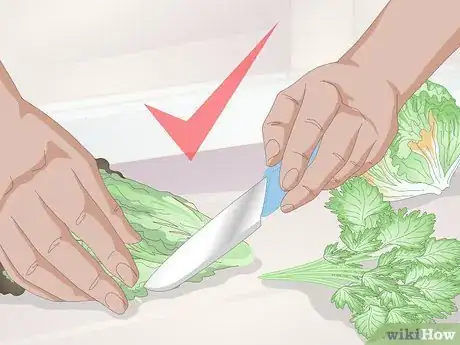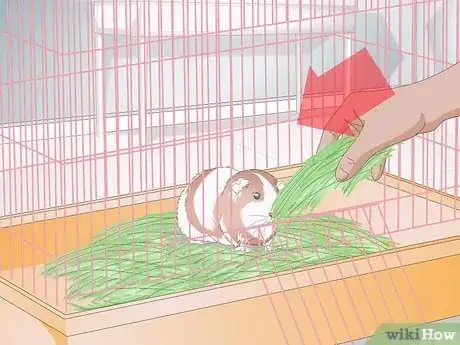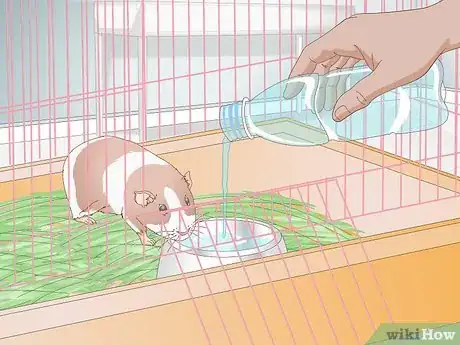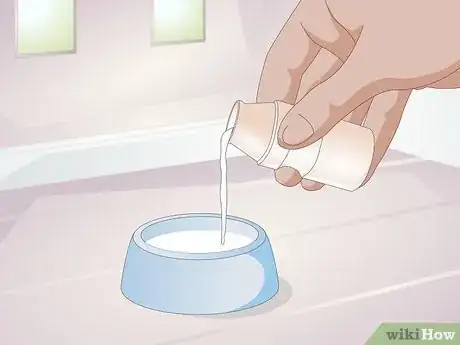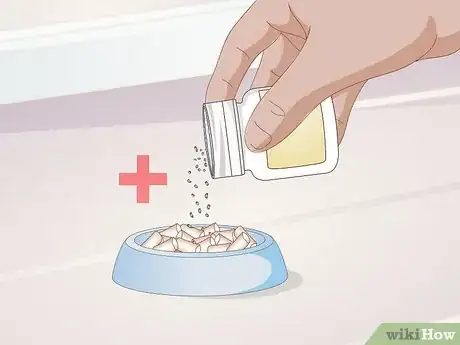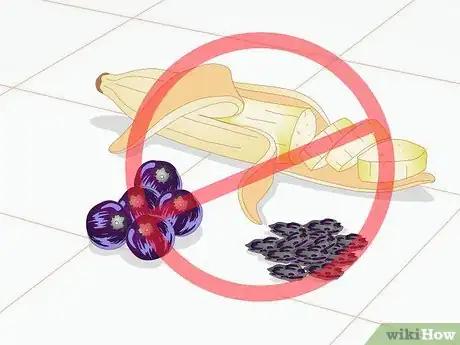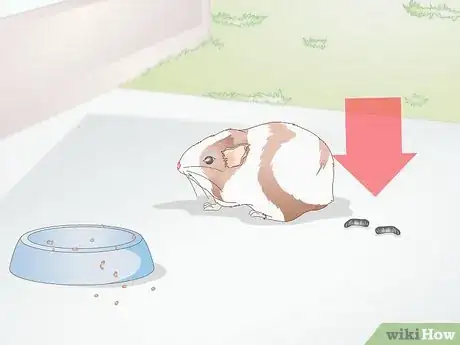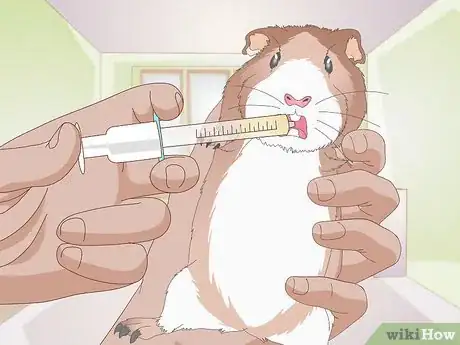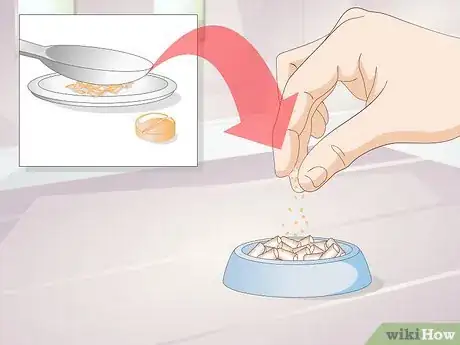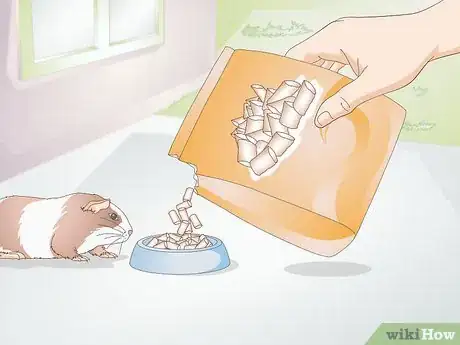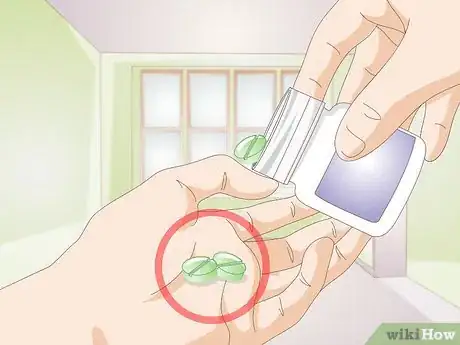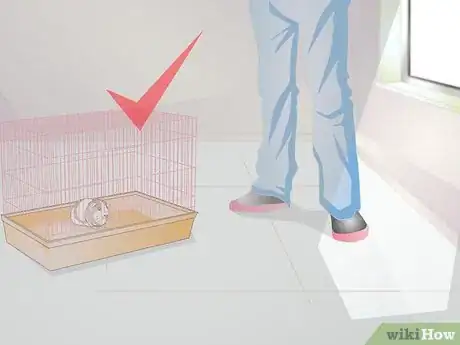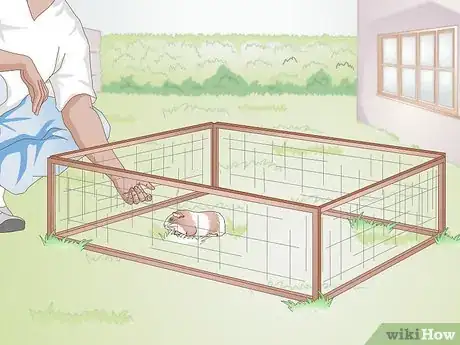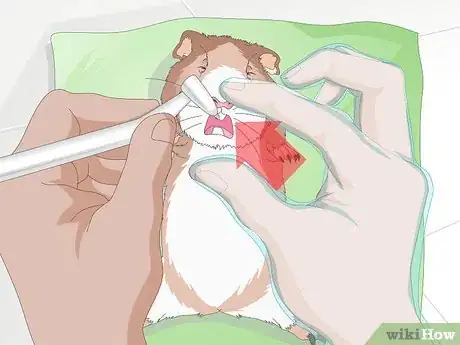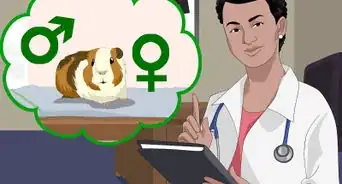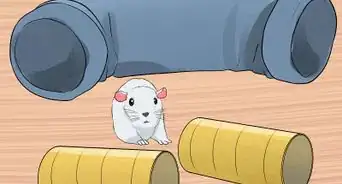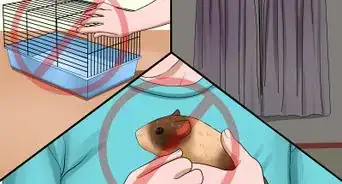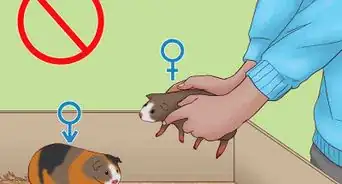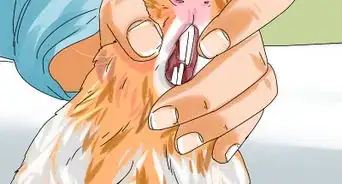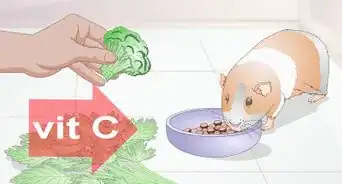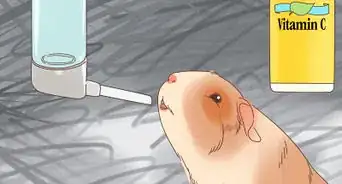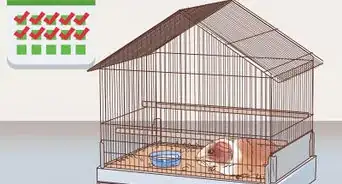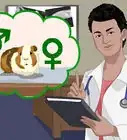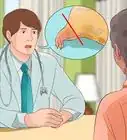This article was co-authored by Pippa Elliott, MRCVS. Dr. Elliott, BVMS, MRCVS is a veterinarian with over 30 years of experience in veterinary surgery and companion animal practice. She graduated from the University of Glasgow in 1987 with a degree in veterinary medicine and surgery. She has worked at the same animal clinic in her hometown for over 20 years.
There are 10 references cited in this article, which can be found at the bottom of the page.
This article has been viewed 23,793 times.
In general, guinea pigs are healthy animals. However, because they have sensitive gastrointestinal (GI) tracts, guinea pigs can develop digestive problems that can make them very sick.[1] Treating a guinea pig for GI problems involves dietary changes, medication, and other treatment strategies to make the guinea pig and its GI tract healthy again. After your vet has diagnosed your guinea pig with a GI problem, start treatment right away.
Steps
Changing Your Guinea Pig’s Diet
-
1Feed your guinea pig fresh, moist vegetables. Changing your guinea pig’s diet is one of the best ways to improve your guinea pig’s GI health. Fresh and moist green vegetables will give your guinea pig the roughage it needs to keep food moving through its GI tract. Examples of green vegetables are parsley, spinach, collard greens, and romaine lettuce.
- Vegetables are a good source of important nutrients, like vitamin C.
- Rinse the vegetables to remove pesticides. After rinsing, chop the vegetables into small pieces that your guinea pig can eat easily.
- Regularly remove uneaten vegetables from your guinea pig's cage to prevent food spoilage.
-
2Include grass hay in your guinea pig’s diet. Grass hay is another great source of roughage for a guinea pig.[2] Examples of grass hay are timothy hay, orchard grass, and oat hay. Give your guinea pig unlimited grass hay. Also, feed your guinea pig different types of grass hay so it doesn’t get bored with just one type.
- Grass hay helps a guinea pig digest its food. Place the hay in a small rack in the cage so the hay doesn't get contaminated with urine or feces.[3]
- Look for hay at your local pet store. The hay should be green and soft.
Advertisement -
3Give your guinea pig fresh water. Fresh water is very important to a guinea pig’s diet. Make sure your guinea pig has access to fresh water at all times. If your guinea pig is not able to drink water on its own, your vet will give it fluids by injection.[4]
- Moist green vegetables will help your guinea pig drink more water.
-
4Consider giving your guinea pig a probiotic. Probiotics are products containing large amounts of healthy bacteria.[5] Probiotics can increase the amount of good bacteria in your guinea pig’s GI tract. However, probiotics have not been shown to be very effective in small pets like guinea pigs.[6]
- Ask your vet what probiotics they recommend for your guinea pig. They will likely suggest a paste or powder intended specifically for guinea pigs.
-
5Add a vitamin C supplement to your guinea pig’s diet. Vitamin C is an important nutrient for guinea pigs that they must get from their diet. If your guinea pig GI’s problem has caused it to stop eating, it will be deficient in vitamin C.[7] In addition to getting vitamin C from foods like dark leafy greens, your vet may recommend a vitamin C supplement for your guinea pig.
- Follow your vet’s instructions for adding the vitamin C supplement to your guinea pig’s diet.
-
6Do not feed your guinea pig sweet, starchy foods. Sugary, starchy foods are not good for guinea pigs. Examples of high-sugar foods to avoid are grapes, raisins, and bananas.[8]
-
7Observe an increased appetite and fecal output. With a fresh, healthy diet, your guinea pig should start feeling better, eating more, and pooping more. However, if your guinea pig’s appetite doesn’t improve and you don’t see more feces in the cage, talk to your vet about other feeding options.
-
8Feed gruel to your guinea pig. If your guinea pig is unable or unwilling to eat food on its own, you will need to feed it with a syringe. Specific gruel products, like Oxbow Critical Care, provide nutrition for guinea pigs until they get their appetites back and start producing feces again.[9]
- Use a 1 milliliter syringe to feed your guinea pig. Holding your guinea pig, place the syringe into the back corner of its mouth. Slowly empty about ¼ of the syringe at a time into your guinea pig’s mouth. Allow your guinea pig to swallow the gruel before feeding it more.[10]
- If purchasing this gruel is not convenient for you, make your own gruel using food your guinea pig would normally eat. For example, grind up guinea pig pellets and mix them together with vegetables and water to make a gruel.
Treating Your Guinea Pig with Medications
-
1Give your guinea pig an antibiotic. Antibiotics called ‘broad spectrum’ antibiotics kill a wide range of bacteria.[11] Guinea pigs are very sensitive to certain antibiotics, though, so your vet will be very careful with selecting an antibiotic for your guinea pig.[12] Whichever antibiotic your vet prescribes, following the prescription instructions carefully.
- Guinea pigs can develop a condition called antibiotic-associated enterotoxemia, which causes brown watery diarrhea, extreme dehydration, and hypothermia. Guinea pigs with this condition can die within one to two days of showing symptoms.[13]
- If your guinea pig becomes extremely ill while on antibiotic treatment, take it your vet immediately.
-
2Increase food movement through your guinea pig’s GI tract. A diet high in roughage provides fiber that will help move food through the GI tract. Sometimes, though, a guinea pig may need medication to improve food movement. This medication should be used only if there is no obstruction or perforation (holes) in the GI tract.[14]
- If food can’t move past the obstruction, the medication could worsen the GI problem.
-
3Reduce your guinea pig’s pain. If your guinea pig’s abdomen is distended because of gas buildup, your guinea pig will be in a lot of pain. Your vet will prescribe a pain medication (carprofen, meloxicam) to relieve that pain.
- Pain can reduce food movement through the GI tract, which could worsen your guinea pig’s GI problem.[15]
-
4Relieve your guinea pig’s gas. Just relieving the gas-related pain won’t relieve the gas itself. A product called simethicone relieves gas.[16] Other gas reliefs are also available, so your vet will recommend which product to use, and explain how to use it.
- Your vet may want to perform a procedure to reduce the gas distension. For example, with your guinea pig anesthetized, your vet would insert a stomach tube down your guinea pig’s throat to its stomach to let the gas out.
Following Other Treatment Strategies
-
1Move your guinea pig’s cage to a dark, quiet area. Your guinea pig will feel pretty lousy when it has a GI problem. Before you begin treating your guinea pig, move its cage to a dark and quiet area of your home.[17] This will help your guinea feel safe and comfortable as it recovers.
- If your guinea pig has a cage mate, separate it from the cage mate until its treatment is complete.
-
2Exercise your guinea pig each day. Exercise increases food movement through the GI tract. Exercise your guinea pig for 10 to 15 minutes about every 8 hours. You can either create a guinea pig-proof play area in your home or allow your guinea pig outside in an enclosed grazing area.
- To guinea pig-proof a room, remove all electrical wires and cords. Also, block access to stairs and cover all vents.
- In the outdoor grazing area, your guinea pig could nibble on grass, which would increase its roughage and fiber intake.[18]
-
3Have your vet trim your guinea pig’s teeth. Dental problems, especially overgrown incisors or molars, can make it difficult for a guinea pig to eat. If a guinea pig can’t eat, it may develop a GI problem. To prevent overgrown teeth, your vet can trim them.
- Do not try to trim your guinea pig’s teeth by yourself. You could end up splitting the teeth and making the dental problem even worse.
Warnings
- Your guinea pig will need to be hospitalized if it is extremely sick. Your vet will give your guinea pig intensive supportive care, such as fluid therapy, to help it feel better.[20]⧼thumbs_response⧽
- A guinea pig with a GI blockage and gas distension usually does not have a good prognosis.⧼thumbs_response⧽
- Antibiotics can make GI problems worse by causing a big imbalance between good and bad bacteria in the GI tract.[21]⧼thumbs_response⧽
- Do not purchase antibiotics at your pet store. They may not be effective.[22]⧼thumbs_response⧽
- Surgery can worsen GI stasis (lack of food movement through the gut). Therefore, surgery is usually not recommended to correct GI problems in guinea pigs.⧼thumbs_response⧽
- Do not give dairy products to your guinea pig, as they may cause diarrhea.⧼thumbs_response⧽
References
- ↑ http://www.vcahospitals.com/main/pet-health-information/article/animal-health/guinea-pigs-problems/1070
- ↑ http://www.merckvetmanual.com/pethealth/exotic_pets/guinea_pigs/disorders_and_diseases_of_guinea_pigs.html
- ↑ https://kb.rspca.org.au/knowledge-base/what-should-i-feed-my-guinea-pigs/
- ↑ www.merckvetmanual.com/pethealth/exotic_pets/guinea_pigs/disorders_and_diseases_of_guinea_pigs.html
- ↑ http://www.webmd.com/digestive-disorders/features/what-are-probiotics#1
- ↑ https://www.dvm360.com/view/how-i-treat-gastrointestinal-stasis-small-herbivores-proceedings
- ↑ https://www.dvm360.com/view/how-i-treat-gastrointestinal-stasis-small-herbivores-proceedings
- ↑ http://www.drexotic.com/care-and-feeding-of-guinea-pigs/
- ↑ https://www.dvm360.com/view/how-i-treat-gastrointestinal-stasis-small-herbivores-proceedings
- ↑ www.guinealynx.info/handfeeding.html
- ↑ https://www.dvm360.com/view/how-i-treat-gastrointestinal-stasis-small-herbivores-proceedings
- ↑ www.merckvetmanual.com/pethealth/exotic_pets/guinea_pigs/disorders_and_diseases_of_guinea_pigs.html
- ↑ http://dora.missouri.edu/guinea-pig/antibiotic-induced-enterotoxemia-hemorrhagic-typhlitis/
- ↑ https://www.dvm360.com/view/how-i-treat-gastrointestinal-stasis-small-herbivores-proceedings
- ↑ https://www.dvm360.com/view/how-i-treat-gastrointestinal-stasis-small-herbivores-proceedings
- ↑ https://bluepearlvet.com/medical-articles/guinea-pig-g-i-oral-and-intestinal-disease/
- ↑ https://www.dvm360.com/view/how-i-treat-gastrointestinal-stasis-small-herbivores-proceedings
- ↑ https://www.dvm360.com/view/how-i-treat-gastrointestinal-stasis-small-herbivores-proceedings
- ↑ https://www.dvm360.com/view/how-i-treat-gastrointestinal-stasis-small-herbivores-proceedings
- ↑ https://www.dvm360.com/view/how-i-treat-gastrointestinal-stasis-small-herbivores-proceedings
- ↑ www.merckvetmanual.com/pethealth/exotic_pets/guinea_pigs/disorders_and_diseases_of_guinea_pigs.html
- ↑ http://www.vcahospitals.com/main/pet-health-information/article/animal-health/guinea-pigs-problems/1070
About This Article
If you think your guinea pig has gastrointestinal problems, take it to the vet immediately for diagnosis. Once your vet has confirmed your guinea pig's gastrointestinal problems, change its diet to promote better digestion by providing fresh, moist vegetables as well as grass hay for it to eat. Your vet may also recommend you give your guinea pig a probiotic or vitamin C supplement, especially if your guinea pig's intestinal problems have caused it to stop eating. In more extreme cases, where your guinea pig is unable to eat at all, you may need to feed it gruel with a syringe. For more tips from our Veterinary co-author, including additional treatment options for your guinea pig's gastrointestinal problems, keep reading.
